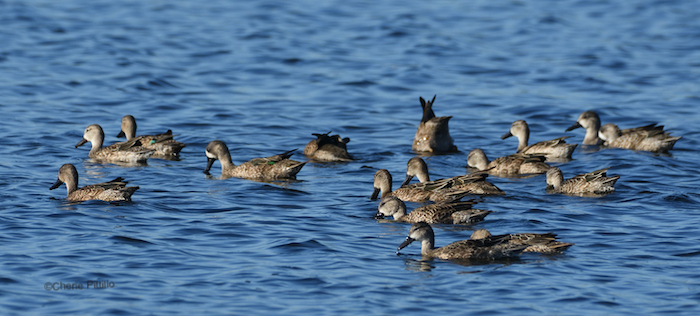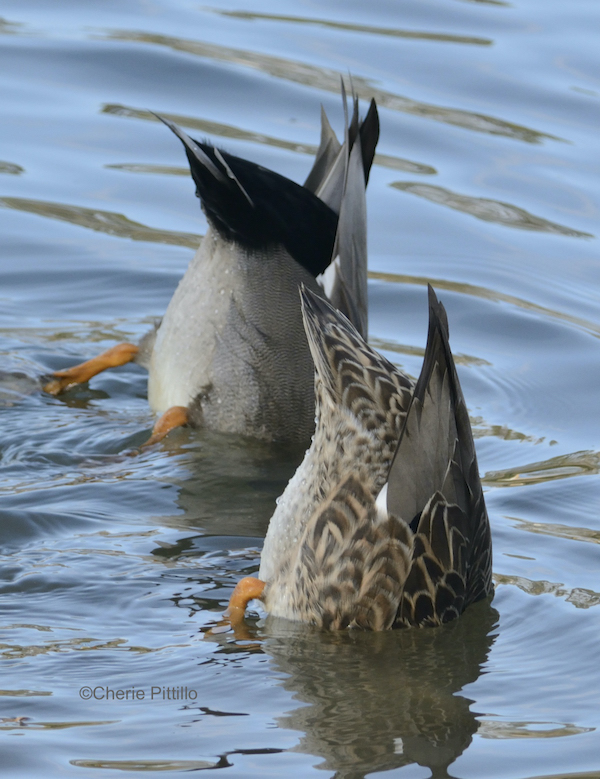Learning about waterfowl bills with tongue spikes, teeth-like ridges, and taste buds were probably a shocker in last month’s column.* I have another function for “duck-like bills” I didn’t mention. A Canada Goose threat display may include head pumping, honking, and hissing, but also the threat includes an open bill with a raised tongue which is quite noticeable to an intruder.

Now let’s continue with Part 2, to review two general groups of ducks, more or less, the dabblers and divers, based on their feeding methods using those diverse bills. By the way taxonomists do not agree on how to split the duck family into a variety of subfamilies and tribes. Therefore even general comments I’ve written may not be definitive. I’ve been confused most of the month between the online references!
DABBLERS
Dabblers tip up or dabble in water to forage and include ducks but also swans, and geese. Rarely do they dive but they may also nibble, skim, or scoop up their diets as well as graze on land. They have more than one way to acquire food which are typically seeds, fruits, aquatic plants and invertebrates.

Plus think about the long necks of geese and swans as foraging adaptations. When they dabble, they can reach different water depths than their short-necked cousins. Those two white lumps on the far left in the Trumpeter Swan image below use those 30” long necks to reach food.

Another appropriate name for dabblers is puddle ducks which can feed in flooded fields, ditches, and marshes. I wonder if a flock of puddle ducks muddle the water and therefore make the “water foul?”


Here are three examples of dabbling duck bills not included in Part 1. Note how the Wood Duck pair with their shorter and narrower bills compare with other dabblers. Their bills are adapted to pick up acorns in woody habitats and to snip off plant bulbs in freshwater marshes.



DIVERS
As expected diving ducks can dive beneath water to search for fish, insects, and aquatic plants. Some scientists place diving ducks into three groups of pochards, stiff-tails, and sea-ducks in North America.
POCHARDS
Pochards can be used as a general term for certain diving ducks in North America such as scaup, Canvasbacks, Redheads, and Ring-necked Ducks. They occur more in estuaries and tidal lagoons than open ocean.
Confusion arises because pochards can be other diving duck names not found in North America.
Here are two examples of divers’ bills:
Redheads graze on submerged aquatic plants, plus eat tubers and some invertebrates.


Ring-necked Ducks eat seeds especially from wild rice and various plants along with aquatic insects.

On the other hand, er, foot, the larger feet and stouter legs of diving ducks are farther back on their bodies than dabblers. Using only their feet they can powerfully propel through water, dive deeper, and slow their metabolism during dives. However, that leg position hinders them to feed on land like dabblers.
STIFF-TAILS
Only two species occur in North America, the Masked Duck and the most common Ruddy Duck. Stiff-tails are so named because they can erect their pointed tail feathers upward, especially at rest. However, when I tried to photograph the Ruddy Duck tails, they were stiff-less. Smaller than a crow, its compact size, blue-colored bill, and erect tail feathers earn cute comments from birders about its appearance.
PHOTO 13 Ruddy Duck and certain other diving ducks are called “Stiff-Tails.” Unfortunately I don’t have a picture showing that.

These fresh-water divers’ feet are twice as powerful as that of the larger Mallard. As a tactile feeder, their diet is about 70% plants and 30% animal but with those powerful feet they may reach underwater food that other waterfowl can’t.
SEA-DUCKS
Sea-ducks includes eiders, scoters, goldeneyes, Long-tailed Ducks, Harlequins, and mergansers. As divers in the sea or along the coast, these maritime waterfowl use their feet and wings while swimming under water unlike the pochards that use only their feet. Living along coastal habitats they can range further inland during nesting and migration. Due to their marine lifestyle, salt glands, kidneys, and possible the intestinal tract assist in salt tolerance.
Now that I have dabbled a bit into duck bills, it’s time to duck out of this column.
MAKE TIME TO DABBLE OR DIVE INTO NATURE.
SPECIES LIST:
PART 1
**Black-bellied Whistling-Duck, Dendrocygna autumnalis, Pijije Alas Blancas (Spanish)
**American Flamingo, Phoenicopterus ruber, Flamenco Americano (Spanish), Mekoh (Mayan)
**Northern Shoveler, Spatula clypeata, Pato Cucharón Norteño
**Blue-winged Teal, Spatula discors, Cercate Alas Azules (Spanish)
Canada Goose, Branta canadensis
Mottled Duck, Anas fulvigula
º Snow Goose, Anser caerulescens
△ Mallard, Anas platyrhynchos, Pato de Collar (Spanish)
PART 2
**Gadwall, Mareca strepera, Pato Friso (Spanish)
Canada Goose, Branta canadensis
Trumpeter Swan, Cygnus buccinator
**Blue-winged Teal, Spatula discors, Cercate Alas Azules (Spanish)
º Wood Duck, Aix sponsa, Pato Arcoiris (Spanish)
**Northern Pintail, Anas acuta, Pato Golondrino (Spanish)
**American Wigeon, Mareca americana, Pato Chalcuán (Spanish)
**Redhead, Aythya americana, Pato Cabeza Roja (Spanish)
**Ring-necked Duck, Aythya collaris, Pato Pico Anillado (Spanish)
**Ruddy Duck, Oxyura jamaicensis, Pato Tepalcate (Spanish)
** Winter visitors in the Yucatan Peninsula except Black-bellied Whistling-Duck and American Flamingo are permanent residents
º Occasional visitor (Wood Duck and Snow Goose)
△ Mallard is an accidental summer resident that may reproduce
Canada Goose and Trumpeter Swan in US and Canada; Canada Goose also occurs in Mexico but not the Yucatan Peninsula
DISCLAIMER: References do not agree or may have not updated recent information.
Yucatan Peninsula Bird List/July 2019, Sal a Pajarear Yucatán (Guía de Aves), Birds and Reserves of the Yucatán Peninsula. A Guide to Birds of Mexico and Northern Central America, What It’s Like To Be A Bird
https://birdsoftheworld.org/bow/home
https://www.allaboutbirds.org/guide/Canada_Goose/lifehistory
https://birdsoftheworld.org/bow/species/cangoo/cur/foodhabits#feeding
https://www.allaboutbirds.org/guide/Mottled_Duck/id
https://birdsoftheworld.org/bow/species/wooduc/cur/introduction
https://birdsoftheworld.org/bow/species/wooduc/cur/foodhabits
https://www.britannica.com/animal/diving-duck
https://www.thespruce.com/types-of-ducks-387310
https://digitalcommons.unl.edu/biosciwaterfowlna/14/
http://bioweb.uwlax.edu/bio203/s2009/beckwith_kayl/Adaptation.htm
https://www.ducks.org/conservation/waterfowl-research-science/waterfowl-feeding-adaptations
https://www.ducks.org/conservation/waterfowl-research-science/the-big-four-diving-ducks
https://www.ducks.org/hunting/waterfowl-id/Dabbling
Cherie Pittillo, “nature inspired,” photographer and author, explores nature everywhere she goes. She’s identified 56 bird species in her Merida, Yucatan backyard view. Her monthly column features anecdotes about birding in Merida, Yucatan and also wildlife beyond the Yucatan.
Contact: [email protected] All rights reserved, ©Cherie Pittillo




4 comments
As usual, Cherie, your photos and information are fantástic but you went overboard on your puns! I think you could win a competition for inventing more than anyone else in a limited space! Ha! Ha! Ha! Abrazos, Barbara
Glad you could laugh! I think I could finally after all the conflicting research. Thanks for your support and time to write a response, Barbara MacKinnon!
Barbara is right–good set of puns. And superb images as well. I didn’t know that mergansers were a sea duck! Thanks again for such an interesting article.
Glad you liked the puns and the last two articles, Bruce. I was surprised at that merganser classification, too. That was just one more facet of conflicting information.